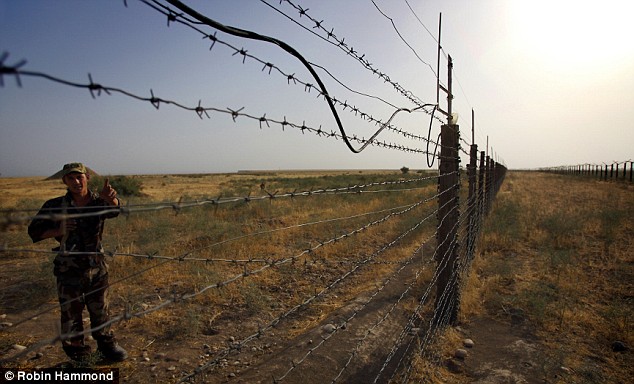
The Taliban and Islamic State Haunt Tajikistan
Publication: Eurasia Daily Monitor Volume: 12 Issue: 99
By:

The specter of a spill-over of violence from Afghanistan continues to haunt Tajikistan. According to the narrative being put forward by the Russian and Tajikistani governments, the Taliban is strengthening its position in northern Afghanistan and its forces are on the verge of invading Tajikistan. They are joined by another bogeyman, the Islamic State, whose militants, officials argue, have started appearing on the border with Tajikistan.
Speaking at a summit of Commonwealth of Independent States (CIS) leaders before Moscow’s Victory Day parade, Tajikistani President Emomali Rahmon highlighted the threat the Afghan conflict poses to his country. “The flurry of activity by the Taliban near the border of the CIS, as well as the appearance of the components of the so-called Islamic State, poses a threat to the whole Commonwealth,” he told the other leaders (Asia Plus, May 11).
Responding to the threat, on May 15, Tajikistan’s government banned foreigners from visiting the country’s mountainous Badakhshan region (Ozodagon, May 15). Although the ban was lifted after just two days, the security services warned that the threat has not disappeared. One member of the Tajikistani security services told the official Russian press agency TASS that 80 percent of Afghanistan’s Badakhshan province (which borders on Tajikistan) is now under Taliban control (TASS, May 15). According to the security services, at least 30 Tajikistani citizens are fighting on the side of the Taliban across the border in Afghanistan (Asia Plus, May 21).
The Russian-led Collective Security Treaty Organization (CSTO) has consistently warned of the potential spill-over of violence from Tajikistan and argued it is best placed to protect this Central Asian republic. Last week the organization flexed its muscles along the border between Tajikistan and Afghanistan. On May 17, it started a spot drill of its Collective Rapid Reaction Force. Involving 2,500 troops from Russia, Armenia, Belarus, Kazakhstan, Kyrgyzstan and Tajikistan, the exercise simulated an armed incursion of 700 Taliban fighters into allied territory. Following the exercise, the CSTO’s chief, Nikolai Bordyuzha, re-affirmed his readiness to counter any spill-over from Afghanistan (RIA Novosti, May 20).
Since Russian border guards left in 2005, Russian defense officials have consistently argued that Tajikistan’s 800-mile border with Afghanistan needs shoring up. More recently, Russian officials have warned that the Islamic State poses a threat to Afghanistan. On April 9, Russian Deputy Defense Minister Anatoly Antonov tweeted that “IS [Islamic State] militants have already appeared near Tajikistan’s border. By providing assistance to Tajikistan, we can defend Russia, the CSTO member nations and our allies” (Asia Plus, April 10).
This rhetoric about the threat to Tajikistan has been matched with measures to strengthen the border. In May, Tajikistan created a “second line of defense” along the border with Afghanistan. A government official linked the move to the destabilization of Afghanistan’s Kunduz province, which borders Tajikistan (Interfax, May 4). Russia is also bolstering its military presence in Tajikistan. The 201st Motorized Division’s base in the south of the country is already its largest base outside of the Russian Federation. Nonetheless, in April, Russia announced that by 2020 it will increase the number of soldiers stationed there from 6,000 to 9,000 (Asia Plus, April 3). Russia has also reportedly promised to give $1.2 billion in aid to help Tajikistan combat the threat posed by the Taliban and Islamic State (Kommersant, April 3).
Some local analysts remain skeptical about whether the threat is as serious as the security officials have made it seem. Security expert Davlatkhoja Nazirov argued that “world powers such as the United States and Russia are interested in [spreading] so-called forecasts on threats that are allegedly posed by [the] Islamic State (IS), [the] Taliban and others militants to Central Asia’s nations [sic], first of all Tajikistan” (Asia Plus, March 26). “Neither Islamic State nor Taliban militants will go far from Afghanistan,” he concluded.
Indeed, little evidence exists for many of the security officials’ overblown claims. Tajik expert Qosimsho Iskandarov questioned whether the Taliban controlled 80 percent of the border with Tajikistan, telling Radio Ozodi that they “will not break through the border” (Radio Ozodi, May 16). Furthermore, despite the CSTO’s claims to the contrary, the Islamic State’s position in Afghanistan remains exceedingly weak. According to Afghan analyst Borhan Osman, much of the reporting on the Islamic State’s presence in Afghanistan is speculative, and little evidence exists indicating that they enjoy support in the country (AAN, February 14).
Even if the Taliban is growing stronger, it remains unlikely that it will attempt an invasion of Central Asia. Its leadership has shown little or no interest in Afghanistan’s northern neighbor. Although shootings remain common, armed incursions in Tajikistani territory remain exceedingly rare. An armed clash on the border in September 2010 left 20 militants dead (Reuters, September 11, 2010). In December 2014, Taliban fighters kidnapped four Tajikistani border guards (Svoboda, December 22). Such incidents remain the exception not the rule.
So if the threat posed to Tajikistan remains more rhetoric than reality, what do officials gain from this discourse of danger? For the Tajikistani side, by presenting its country as at-risk of incursion, the government can secure a steady flow of cash and weapons from Moscow. But Moscow’s help comes at a price: Dushanbe remains firmly under Russia’s influence. With instability in Afghanistan set to continue after the end of the International Stability and Assistance Force (ISAF) mission and well into the future, this relationship will not change any time soon.




